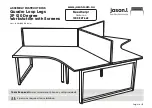
Installation Guidelines
Water Quality
Solids in your water supply act as abrasives and
will wear away the water measuring mechanism. If
you have problems with solids, install a filter
upstream of the injector and place pressure
gauges before and after. You can use the
difference in pressure readings to tell when the
filter is plugged up.
Preparation
Refer to the examples on pages 2 & 3 to help you
with assembly and installation. You will need PVC
pipe cleaner and glue to complete assembly;
these are available at most hardware and home
improvement stores.
Other piping can be of your preference.
Installation Pointers &
Recommendations
(1) A check valve or backflow preventer
should be installed in the main line before
the by-pass and injector. Comply with
local codes.
(2) Any on-off water valve should be installed
downstream from the blending tank. This
will insure that the system injection point
will always be pressurized, making
siphoning of chemical unlikely.
(3) Suction lines may be plumbed with rigid
PVC piping for a neater installation.
PH & EC Monitors
(4) PH and EC sensors should be installed in
a three valve bypass so they can be
isolated for calibration and repair.
(5) The main-line bypass valve should be
partially closed to insure water flow
through the bypass.
(6) Install the bypass for pH and EC sensors
below the main water line to ensure they
are never dry.
(7) Install a PVC Bushing & 1/2" NPT boiler
drain for taking water samples.
Assembly
NOTES: See your pumper manual for
complete information on installing the
pumpers.
Do not connect the supply line to the pilot
valve/manifold before flushing the system.
Make wiring connections after plumbing is
complete.
Refer to the installation photos and drawings in
the rear of this manual for information in
assembling your system. If you are unfamiliar with
plumbing or working with the piping materials of
your choice, you should hire a professional
plumber to do the installation.
Beware! Most
plumbers are unfamiliar with our equipment
and should be monitored to see that they are
following our installation recommendations.
Once the plumbing is complete and all pipe
connections are tight, remove the meter from the
system. The piping should not spring apart or
close up when it is removed. Continuous strain
could interfere with operation. Adjust the piping if
necessary.
Before reinstalling the meter, flush the system to
remove metal flakes and other debris from the
plumbing. You should also flush the line that
supplies the pilot valve/manifold before
connecting it to the valve.
Electrical Connections
Refer to the manual
Series J Plus Pumper
Controllers
for the terminal locations. The flow
sensor and valve outputs should be connected
before wiring the power connections.
WARNING! Connecting the flow
sensor incorrectly can damage
the flow sensor electronics.
The terminals on the flow sensor terminal block
are labeled 1, 2, & 3, both on the terminal board
and on the sensor cable. Be certain to match
numbers when connecting these wires. If you
need a longer cable, use the color coding to be
sure that these connections are correct.
The manifold valve terminals are numbered on the
4-output terminal block. On the 2-output model,
valve #1 is on the left side.
H.E. Anderson Co.
6
IGHC-11-10



























